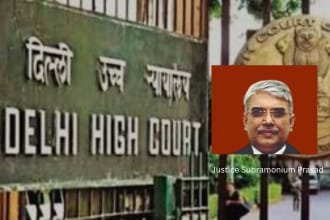In a significant development concerning the protection of religious structures, the Supreme Court of India on April 17, 2025, intervened to stay the demolition of the Hazrat Satpeer Dargah in Nashik, Maharashtra. The apex court also sought an explanation from the Bombay High Court’s Registrar General regarding the delay in listing a plea filed by the Dargah’s trust against the demolition notice issued by the Nashik Municipal Corporation.
Background of the Case
The case, titled Baba Hazrat Satpeer Dargah v. Nashik Municipal Corporation, arose after the Nashik civic body initiated a demolition drive around the Satpeer Dargah, a religious site that has been at the center of public attention. The Dargah’s trust filed a writ petition before the Bombay High Court on April 8, 2025, challenging the legality of the demolition notice. However, despite repeated requests, the matter was allegedly not listed for urgent hearing by the High Court.
Supreme Court’s Intervention
A bench comprising Justices PS Narasimha and Joymalya Bagchi expressed serious concern over the delay in the High Court’s listing of the case. The Supreme Court, taking an “extraordinary measure,” stayed the demolition and issued a notice to the Registrar General of the Bombay High Court, asking for a detailed report on the listing process of the writ petition.
The Court observed:
“We are unable to understand as to what transpired from 9th of April till today. Learned counsel submits that they have been trying every day (to get the matter listed).”
The bench made it clear that such allegations regarding the inaction of the High Court are serious and that the counsel appearing for the petitioner should be mindful of the consequences of making such a claim. Nevertheless, the Court acted to preserve the status quo, noting the urgency of the matter due to the risk of irreparable damage to the religious structure.
Legal Representation
The petitioner was represented by Senior Advocate Navin Pahwa, along with Advocate-on-Record Jasmeet Singh. They argued that the Nashik Municipal Corporation’s actions were arbitrary and that the delay in judicial hearing had left the religious trust without a remedy.
Supreme Court’s Directions
The apex court has now:
- Stayed the demolition of the Hazrat Satpeer Dargah until further orders.
- Directed the Registrar General of the Bombay High Court to file a report explaining why the writ petition, filed on April 8 and repeatedly mentioned for urgent listing from April 9 onwards, was not listed for hearing.
- Fixed the next hearing of the matter for April 21, 2025.
The Larger Context: Demolition Drives and Religious Structures
The Satpeer Dargah case is yet another instance in a series of legal battles over demolition drives targeting religious or historic structures. In recent years, courts across India have been asked to intervene in similar matters involving temples, mosques, dargahs, and churches, where state action is often met with claims of cultural or constitutional violation.
The Supreme Court has previously held that religious structures cannot be demolished arbitrarily and that due process must be followed, especially when Article 25 (freedom of religion) and Article 26 (freedom to manage religious affairs) of the Constitution are invoked by the petitioners.
This intervention reflects the judiciary’s balancing act between urban planning and heritage preservation, as well as executive accountability in municipal actions.
Delay in Judicial Listing: A Matter of Procedural Fairness
The top court’s sharp observations on the Bombay High Court’s delay underscore a recurring concern within the Indian judicial system—timely access to justice. The Supreme Court noted that it was “unsure of the statement” that the High Court had not listed the matter despite repeated requests, but considered the allegation serious enough to warrant a formal report from the Registrar General.
This reflects the judiciary’s internal check-and-balance mechanism, ensuring that procedural delays do not lead to irreversible consequences like the demolition of religious or heritage sites.
What’s Next?
The matter will come up again on April 21, 2025, before the Supreme Court. By then, the Bombay High Court’s Registrar General is expected to submit a detailed report regarding the listing status of the petition filed on April 8. The apex court’s further directions will likely depend on:
- The Registrar’s report on listing delays,
- Submissions from the Nashik Municipal Corporation justifying the demolition,
- And the petitioner’s argument regarding the religious and historical significance of the structure.
Legal Implications and Takeaways
- Urgency Matters: The Supreme Court’s decision to stay the demolition shows how urgency in legal matters, especially involving potential irreversible damage, can invoke extraordinary judicial remedies.
- Transparency in Listings: The case may lead to introspection and reform in how High Courts prioritize urgent listings, ensuring that procedural lapses do not thwart justice.
- Protection of Religious Sites: While municipal corporations have a duty to enforce laws and remove encroachments, actions against religious structures require heightened judicial scrutiny.
- Judicial Accountability: By demanding a report from the Bombay High Court, the Supreme Court has reaffirmed that all organs of the judiciary are accountable in maintaining the public’s trust.
Conclusion
The Supreme Court’s intervention in the Hazrat Satpeer Dargah demolition case is a landmark development highlighting the role of the judiciary in safeguarding constitutional rights and ensuring procedural fairness. The decision to stay the demolition and demand accountability from the High Court indicates a robust approach to upholding the rule of law, especially in sensitive matters involving religious structures.
As the matter returns for hearing on April 21, stakeholders across the legal, administrative, and religious spectrum will keenly observe how the Court navigates the competing interests of municipal governance, judicial efficiency, and religious freedom.



